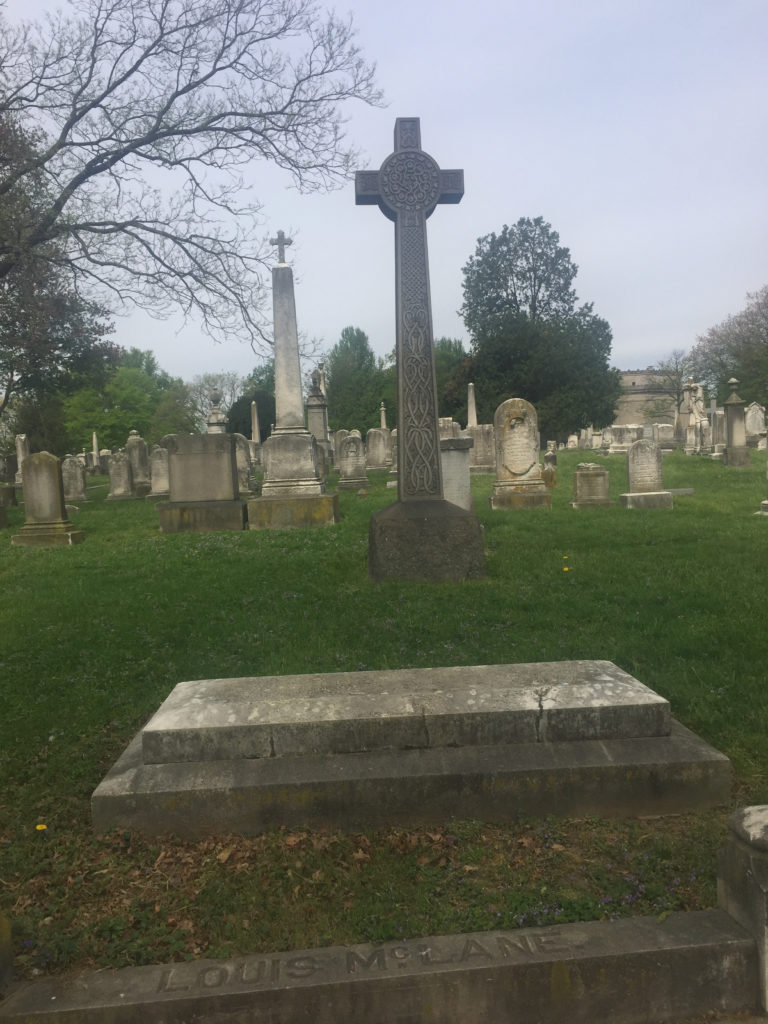Erik Visits an American Grave, Part 913
This is the grave of Louis McLane.

Born in 1786 in Smyrna, Delaware (is this first time I’ve ever visited a grave of someone from Delaware; I know I’ve never visited a grave in the First State), McLane grew up in the Early Republic elite. George Washington had named his father the Customs collector for the Port of Wilmington, the kind of sweet patronage position that really secured someone as a member of the rich. This was a hard-core Federalist family, which of course Washington was comfortable with. The thing about this position is that the collector got to keep most of the confiscated booty from illegal smuggling and the like. So that made the family super rich. That McLane managed to hold the job until his death in the 1830s definitely helped. So young Louis had no financial problems growing up.
McLane went to fancy schools and joined the Navy for a year before going to college at Newark College, which later became the University of Delaware. He became a lawyer, passed the bar in 1807, and started a practice in Wilmington. Despite his Federalist leanings, he formed a militia to defend Wilmington in the War of 1812, not that the British really targeted it. He never saw any military action.
McLane became key to the Federalist Party in Delaware and won his first election to Congress in 1817 on what would become Whig positions, though of course the party wasn’t yet formed. He would stay in Congress for the next 10 years, becoming Chair of the House Ways and Means Committee in 1822, a very powerful position. But as time went on, McLane became more comfortable with his Democratic colleagues and even wanted to be in the Jackson administration. Some of this was Era of Good Feelings material. By this time, Delaware was basically the only state in the country with a functional Federalist Party, which meant party affiliation was mostly irrelevant in the House, though McLane’s Federalist affiliation did prevent him from being elected Speaker, which he definitely wanted. But also, he became close with leading Democrats such as William Crawford and Martin Van Buren, realizing his politics weren’t that different from theirs.
In 1827, McLane switched to the Democrats and went to the Senate. He supported Andrew Jackson in the 1828 election. He resigned in 1829, knowing that he had burned his bridges in the strongly anti-Jackson state of Delaware and would not be reappointed. He really wanted a Cabinet position. In fact, he expected one. Instead, he was sent to London as minister to the British, which he didn’t want. Van Buren convinced him to take it. He hired Washington Irving as his personal secretary and was pretty successful, working to open up trade with the West Indies. As the British were moving toward free trade, they were amenable to this. But he still wanted to be in the Cabinet. That finally happened in 1831 after Jackson fired all of Calhoun’s supporters. McLane got Treasury. He fought Jackson on the Bank of the United States, hoping it would be rechartered. He was quite skilled at articulating the need for the Bank. But Jackson had other advisors, especially Roger Taney, who argued to kill the bank. Jackson listened to Taney instead of McLane. Jackson liked McLane, but McLane refused to withdraw the deposits from the BUS so he had to fire him. But he wanted to give him something. State was open, so was appointed to that role. He only stayed there for about a year, quitting when Martin Van Buren undermined his hard-line policy against the French refusing to pay required reparations for shipping seized during the Napoleonic Wars.
McLane was pretty well off. But like many elites, he had lots of expenses. Having 13 living children made him need money. Since he was powerful and well-connected, he was quickly tapped to be on the boards of lucrative companies, especially in the canal business. Then he was named head of the new Baltimore and Ohio Railroad, which he jumped at. McLane was basically the first of many, many politicians who would cash in on corporate leadership after leaving office. He stayed in that position all the way until 1848.
McLane was tapped for public service one more time. He was friends with James Polk. So Polk sent him back to London to make the deal to transfer the Oregon Country to the U.S. This was hard because Polk was such a hard-liner and then of course invaded Mexico to expand slavery. The British worried he would do this in British Columbia too. But McLane ensured the British did not support Mexico and used his connections there to reassure the British that the U.S. was happy with the 49th parallel extended to the Pacific. In fact, McLane was pretty outraged by the Polk administration’s belligerent nation. He worried that Polk had come under the influence of ambitious schemers such as Lewis Cass who wanted war in the Northwest to push their own political ambitions. So he and Polk mostly broke and he did not receive a new invitation into the Cabinet that he so badly wanted.
McLane died in 1857. He was 71 years old.
Louis McLane is buried in Green Mount Cemetery, Baltimore, Maryland.
If you would like this series to visit other Cabinet members from the Jackson years, you can donate to cover the required expenses here. John Forsyth is in Washington, D.C., and Lewis Cass is in Detroit. Previous posts in this series are archived here.


